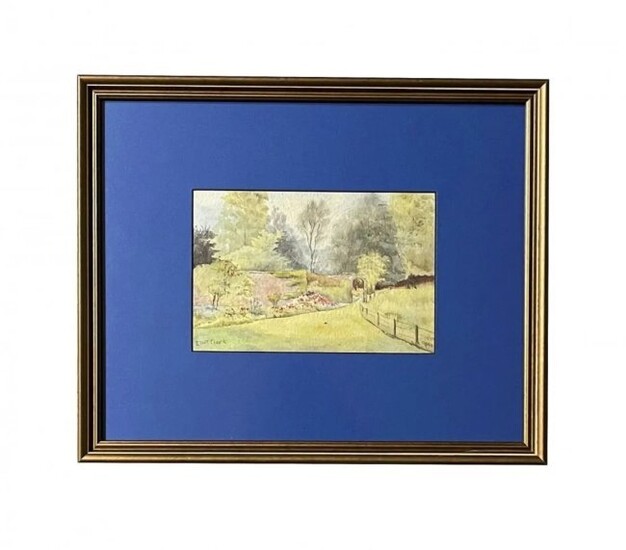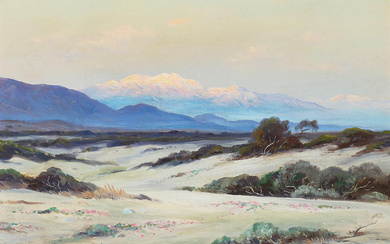Eliot Candee Clark (1883 - 1980) American
Eliot Candee Clark (1883 - 1980) American
Watercolor on Paper
Measure 5 3/4"in H x 8 3/4"in W and 13 1/2"in H x 16 1/2"in W with frame
Known for: Landscape and harbor view painting
Name variants: Elliott Clark
Biography: Eliot Clark was the son of painter Walter Clark (1848-1917). "As a child," he later wrote, "I grew unconsciously in the association of artists, of studio talk and the smell of paint and turpentine." His earliest memories of his father's studio were when it was in the Holbein building in New York City -- above a stable and right next door to the studio of George Inness. No doubt he was instructed at his father's easel from the youngest age (he exhibited two pieces at the New York Water Color Club when he was only nine years old). His first classroom instruction began when he was seventeen. "While still going to school," Clark continued, "I studied in the afternoon for a term at the Art Students League under John Twachtman in the antique class." Clark's painted landscapes in a realist style, which employed broad areas of saturated color while keeping detail to a minimum. He was very planar in his approach to the canvas, dividing it into obvious foreground, middle and background areas. Often he used hills and banks of foliage to accomplish this division. His painting Under the Trees, which employs trees to isolate groups of figures from one another, won for the young artist the Third Hallgarten Prize at the National Academy of Design in 1912. This work falls into Clark's Tonalist phase, but over the years he painted more and more as an Impressionist, letting more light onto his canvas and increasing the intensity and vibrancy of his colors. For most of his professional life, Clark divided his time between New York City and Kent, Connecticut, until 1932 when he bought a summer home amidst the rolling hills of Albermarle County, Virginia. In New York he taught, he wrote, and he was active in artist's clubs. He was elected president of the National Academy of Design in 1956. But in The Old Dominion with the exception of two summers during the Depression when he taught at the University of Virginia -- he spent time traveling throughout the Tidewater, the Delmarva peninsula, and the mountains of western Virginia as well as neighboring West Virginia. He retired to his Albermarle County home in 1959.
Condition Report: Coral Gables Auction strongly encourages in-person inspection of items by the bidder
Statements by Coral Gables Auction regarding the condition of objects are for guidance only And should Not be relied upon as statements of fact, and do Not constitute a representation, warranty, Or assumption of liability by Coral Gables Auction
All lots offered are sold "As Is"
For condition report please contact our auction house via email info.coralgablesauction@yahoo.com
View it on
Estimate
Time, Location
Auction House
Eliot Candee Clark (1883 - 1980) American
Watercolor on Paper
Measure 5 3/4"in H x 8 3/4"in W and 13 1/2"in H x 16 1/2"in W with frame
Known for: Landscape and harbor view painting
Name variants: Elliott Clark
Biography: Eliot Clark was the son of painter Walter Clark (1848-1917). "As a child," he later wrote, "I grew unconsciously in the association of artists, of studio talk and the smell of paint and turpentine." His earliest memories of his father's studio were when it was in the Holbein building in New York City -- above a stable and right next door to the studio of George Inness. No doubt he was instructed at his father's easel from the youngest age (he exhibited two pieces at the New York Water Color Club when he was only nine years old). His first classroom instruction began when he was seventeen. "While still going to school," Clark continued, "I studied in the afternoon for a term at the Art Students League under John Twachtman in the antique class." Clark's painted landscapes in a realist style, which employed broad areas of saturated color while keeping detail to a minimum. He was very planar in his approach to the canvas, dividing it into obvious foreground, middle and background areas. Often he used hills and banks of foliage to accomplish this division. His painting Under the Trees, which employs trees to isolate groups of figures from one another, won for the young artist the Third Hallgarten Prize at the National Academy of Design in 1912. This work falls into Clark's Tonalist phase, but over the years he painted more and more as an Impressionist, letting more light onto his canvas and increasing the intensity and vibrancy of his colors. For most of his professional life, Clark divided his time between New York City and Kent, Connecticut, until 1932 when he bought a summer home amidst the rolling hills of Albermarle County, Virginia. In New York he taught, he wrote, and he was active in artist's clubs. He was elected president of the National Academy of Design in 1956. But in The Old Dominion with the exception of two summers during the Depression when he taught at the University of Virginia -- he spent time traveling throughout the Tidewater, the Delmarva peninsula, and the mountains of western Virginia as well as neighboring West Virginia. He retired to his Albermarle County home in 1959.
Condition Report: Coral Gables Auction strongly encourages in-person inspection of items by the bidder
Statements by Coral Gables Auction regarding the condition of objects are for guidance only And should Not be relied upon as statements of fact, and do Not constitute a representation, warranty, Or assumption of liability by Coral Gables Auction
All lots offered are sold "As Is"
For condition report please contact our auction house via email info.coralgablesauction@yahoo.com




